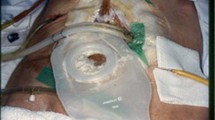Abstract
Introduction
Gastrointestinal cutaneous fistulas are among the more complex surgical conditions, with mortalities in the current series between 6% and 20%, and in some non-U.S. series, up to 40%. The series of principles of recognition, preparation of the abdominal wall, enteral and parenteral nutrition, and support, is outlined. Diagnosis in the absence of signs of sepsis is usually obtained by a fistulagram done by collaboration between the senior surgeon and the senior radiologist and followed to make certain that there is no intestinal obstruction. If spontaneous (nonoperative) closure does not occur in 5 to 6 weeks, it is unlikely to occur and an operation will be required. In our experience, obliterative peritonitis does not subside until a minimum of 4 months, and so an elective operative approach should take place when required after 4 months since the previous operation (when the fistula occurred).
Methods
A technical approach to operation is described. Avoiding enterotomies is critical. The abdomen should be entered in a fresh area, either by an extended incision, or in a virgin area transversely, if the previous incision was vertical and occupied the entire length of the abdomen. It often takes between 1.5 and 2 h to get into the abdomen without making additional enterotomies. The goal is to dissect laterally in one area until one enters a free lateral space which is free of adhesions. One then proceeds from lateral to medial to take down the adhesions from the previous incisions. When one is finished taking down these adhesions, it is usual that only 12 to 18 in. of bowel of the fistula and the surrounding enterotomies requires resection. An end-to-end anastomosis should be performed. Our practice is a two-layer silk-interrupted anastamosis. Adjunctive steps following the operation usually include a gastrostomy and a catheter jejunostomy. In order to be successful, the best results are obtained with a native abdominal wall closure with either component separation or an Abrahamson-type closure. If this cannot be achieved, multiple layers of vicryl are used, which usually enables the fistula to heal; a hernia usually results, but that can be dealt with at some future time. Using these principles, the last 50 cases at our personal series have been done without mortality.




Similar content being viewed by others
References
Lynch AC, Delaney CP, Senagore AJ, Connor JT, Remzi FH, Fazio VW. Clinical outcome and factors predictive of recurrence after enterocutaneous fistula surgery. Ann Surg 2004;240(5):825–831. doi:10.1097/01.sla.0000143895.17811.e3.
Von Allman D, Li S, Hasselgren PO, Fischer JE. Effect of ischemia on protein synthesis in the septic liver. Surg Gynecol Obstet 1991;172:441–448.
Berry SM, Fischer JE. Enterocutaneous fistula. In Wells SA Jr., ed. Current Problems on Surgery. St. Louis: Mosby, 1994, pp 469–576.
Fischer JE. A cautionary note: use of VAC systems may be associated with a higher mortality from fistula development in the treatment of gastrointestinal cutaneous fistulas. Am J Surg 2008;196(1):1–3.
Kuvshinoff BW, Brodish RJ, McFadden DW, Fischer JE. Serum transferrin as a prognostic indicator of spontaneous closure and mortality in gastrointestinal cutaneous fistulas. Ann Surg 1993;217(6):615–622. doi:10.1097/00000658-199306000-00003.
Soeters PB, Ebeid AM, Fischer JE. Review of 464 patients with gastrointestinal fistula impact of parenteral nutrition. Ann Surg 1979;190:189–202. doi:10.1097/00000658-197908000-00012.
Carbonell AM, Kercher KW, Sing RF, Heniford BT. Susceptibility of prosthetic biomaterials to infection. Surg Endosc 2005;19(12):1670. doi:10.1007/s00464-005-0103-z.
Connolly PT, Teubner A, Lees NP, Anderson ID, Scott NA, Carlson GL. Outcome of reconstructive surgery for intestinal fistula in the open abdomen. Ann Surg 2008;247(3):440–444. doi:10.1097/SLA.0b013e3181612c99.
Fischer JE. The importance of reconstruction of the abdominal walls following gastrointestinal fistula closure. Am J Surg Clinical 2009;197(1):131–132.
Goligher JC, Irvin TT. A controlled trial of three methods of closure of laparotomy wounds. Br J Surg 1975;62:823. doi:10.1002/bjs.1800621019.
Bower RM, Cerra FB, Bershosky B et al. Early enteral administration of a formula (Impact) supplemented with anginine nucleotides and fish oil in intensive care unit patients: results of a randomized prospective trial. Crit Care Med 1995;23:436–449. doi:10.1097/00003246-199503000-00006.
Poylin V, Steigman S, Fischer JE. A standardized approach to operation in patients with gastrointestinal cutaneous fistula. 2009 In press.
Author information
Authors and Affiliations
Corresponding author
Rights and permissions
About this article
Cite this article
Osborn, C., Fischer, J.E. How I Do It: Gastrointestinal Cutaneous Fistulas. J Gastrointest Surg 13, 2068–2073 (2009). https://doi.org/10.1007/s11605-009-0922-7
Received:
Accepted:
Published:
Issue Date:
DOI: https://doi.org/10.1007/s11605-009-0922-7




